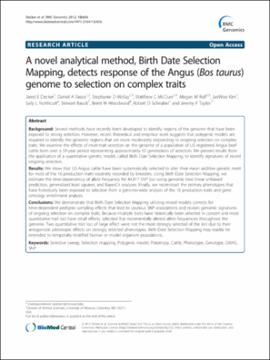| dc.contributor.author | Decker, Jared E. | |
| dc.contributor.author | Vasco, Daniel A. | |
| dc.contributor.author | McKay, Stephanie D. | |
| dc.contributor.author | McClure, Matthew C. | |
| dc.contributor.author | Rolf, Megan M. | |
| dc.contributor.author | Kim, JaeWoo | |
| dc.contributor.author | Northcutt, Sally L. | |
| dc.contributor.author | Bauck, Stewart | |
| dc.contributor.author | Woodward, Brent W. | |
| dc.contributor.author | Schnabel, Robert D. | |
| dc.contributor.author | Taylor, Jeremy F. | |
| dc.date.accessioned | 2018-11-09T21:10:41Z | |
| dc.date.available | 2018-11-09T21:10:41Z | |
| dc.date.issued | 2012-11-09 | |
| dc.identifier | oksd_decker_anovelanalytic_2012 | |
| dc.identifier.citation | Decker, J. E., Vasco, D. A., McKay, S. D., McClure, M. C., Rolf, M. M., Kim, J., ... Taylor, J. F. (2012). A novel analytical method, Birth Date Selection Mapping, detects response of the Angus (Bos taurus) genome to selection on complex traits. BMC Genomics, 13, Article 606. https://doi.org/10.1186/1471-2164-13-606 | |
| dc.identifier.uri | https://hdl.handle.net/11244/302041 | |
| dc.description.abstract | Background: Several methods have recently been developed to identify regions of the genome that have been exposed to strong selection. However, recent theoretical and empirical work suggests that polygenic models are required to identify the genomic regions that are more moderately responding to ongoing selection on complex traits. We examine the effects of multi-trait selection on the genome of a population of US registered Angus beef cattle born over a 50-year period representing approximately 10 generations of selection. We present results from the application of a quantitative genetic model, called Birth Date Selection Mapping, to identify signatures of recent ongoing selection. | |
| dc.description.abstract | Results: We show that US Angus cattle have been systematically selected to alter their mean additive genetic merit for most of the 16 production traits routinely recorded by breeders. Using Birth Date Selection Mapping, we estimate the time-dependency of allele frequency for 44,817 SNP loci using genomic best linear unbiased prediction, generalized least squares, and BayesCpi analyses. Finally, we reconstruct the primary phenotypes that have historically been exposed to selection from a genome-wide analysis of the 16 production traits and gene ontology enrichment analysis. | |
| dc.description.abstract | Conclusions: We demonstrate that Birth Date Selection Mapping utilizing mixed models corrects for time-dependent pedigree sampling effects that lead to spurious SNP associations and reveals genomic signatures of ongoing selection on complex traits. Because multiple traits have historically been selected in concert and most quantitative trait loci have small effects, selection has incrementally altered allele frequencies throughout the genome. Two quantitative trait loci of large effect were not the most strongly selected of the loci due to their antagonistic pleiotropic effects on strongly selected phenotypes. Birth Date Selection Mapping may readily be extended to temporally-stratified human or model organism populations. | |
| dc.format | application/pdf | |
| dc.language | en_US | |
| dc.publisher | BioMed Central | |
| dc.rights | This material has been previously published. In the Oklahoma State University Library's institutional repository this version is made available through the open access principles and the terms of agreement/consent between the author(s) and the publisher. The permission policy on the use, reproduction or distribution of the material falls under fair use for educational, scholarship, and research purposes. Contact Digital Resources and Discovery Services at lib-dls@okstate.edu or 405-744-9161 for further information. | |
| dc.title | Novel analytical method, Birth Date Selection Mapping, detects response of the Angus (Bos taurus) genome to selection on complex traits | |
| osu.filename | oksd_decker_anovelanalytic_2012.pdf | |
| dc.description.peerreview | Peer reviewed | |
| dc.identifier.doi | 10.1186/1471-2164-13-606 | |
| dc.description.department | Animal Science | |
| dc.type.genre | Article | |
| dc.type.material | Text | |
| dc.subject.keywords | selective sweep | |
| dc.subject.keywords | selection mapping | |
| dc.subject.keywords | polygenic model | |
| dc.subject.keywords | pleiotropy | |
| dc.subject.keywords | cattle | |
| dc.subject.keywords | phenotype | |
| dc.subject.keywords | genotype | |
| dc.subject.keywords | GWAS | |
| dc.subject.keywords | SNP | |
